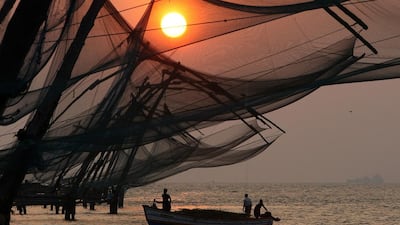Why Kochi?
Still commonly called Cochin, the centuries-old port city on Kerala’s coast was once a centre of spice trade with China, Europe and Arabia. Kochi has passed through the hands of many colonial powers – the Portuguese in the 16th century, the Dutch in the 17th century, and the British in the late 18th century – all of whom flocked to the region for its tea, spice, teak, and rubber. The Portuguese explorer Vasco da Gama made his final journey here in 1524, after which he was buried in the city’s St Francis Church.
The storied history of this city by the Arabian Sea is represented today in its confluence of cultures. Nowhere is this more apparent than in the district of Fort Kochi. The architecture is an amalgamation of styles: 200-year-old colonial teakwood mansions with sloping roofs, open courtyards and shuttered windows stand alongside open-air cafes, art galleries and traditional spice shops. The cuisine makes abundant use of Keralan flavours, but borrows liberally from Portuguese styles. The lingering legacies of transient visitors clubbed with the Malabar region’s ancient history lend Kochi its charming allure.
A comfortable bed
A stone's throw from the water's edge, the boutique Brunton Boatyard (www.cghearth.com) sits in a former shipyard, with views of the pier. The property oozes colonial character, with high ceilings, antique furniture, plus Dutch and Portuguese artefacts. Double rooms cost from 16,000 Indian rupees (Dh897).
The Old Lighthouse Bristow (www.oldlighthousehotel.com) is the former residence of the architect of Kochi's port, Sir Robert Bristow. The restored heritage bungalow has 12 tastefully decorated rooms and suites. The spa, offering a range of Ayurvedic massages, is a boon. Doubles cost from 14,550 rupees (Dh816).
Malabar House (www.malabarhouse.com) is an early 18th-century Dutch villa that passed through the hands of European traders and bankers before being converted to a heritage art hotel in the 1960s. Its excellent restaurant offers an interesting mix of regional and Mediterranean cuisine. Doubles cost from 13,594 rupees (Dh762).
Find your feet
At the northern tip of the Mattancherry Peninsula, Fort Kochi is the city’s thriving historic and cultural heart. The area’s neat streets are ideal for a wander. Colonial mansions, tree-lined courtyards, trendy cafes, art galleries, alfresco restaurants and little boutiques all vie for space on the narrow avenues. The smell of spices such as clove and cinnamon billows out of shopfronts and hangs thick in the air.
Rub shoulders with artsy types at Kashi Art Gallery (www.kashiartgallery.com), a rather bohemian cafe/art gallery that plays host to changing exhibitions.
Contemporary works by upcoming young artists are on display at the David Hall Gallery (www.davidhall.in) – a restored 17th-century Dutch bungalow with a cafe and performance space for live music and film screenings. The St Francis Church, where Da Gama was buried, is nearby.
Meet the locals
The best place for a view of the city’s iconic Chinese fishing nets is Vasco Square on the waterfront. The cantilevered bamboo-and-wood structures fan out in the breeze and look charming during the pink sunsets. Watch fisherman haul in fresh catches early in the morning and sometimes the late afternoon. Enterprising fisher folk have set up stalls where you can buy the fresh catch of your choice, have it smeared in local masalas and cooked right in front of you. Stroll along the promenade, busy with local families and tourists, and watch trading ships roll in.
Book a table
Malabar Junction is the leafy courtyard restaurant at Malabar House, where you can dine alfresco or indoors. The food is an interesting blend of regional dishes and international cuisine, from fresh seafood and hoppers to pastas and sushi. Try the tiger prawns in thakkali curry (a garlicky, tomato-based gravy), served with appams (thin rice pancakes), or the mahi-mahi steak with a distinctly local twist. A meal for two costs about 2,000 rupees (Dh112).
Comprising an extensive seafood menu, the fuss-free Fort House restaurant (www.hotelforthouse.com) in the hotel of the same name is a go-to choice for authentic, home-style Kerala-Christian cuisine. The waterfront location is unbeatable, as is the fresh seafood. Opt for tuna pepper, or spicy, coconut-flavoured, fried Kerala prawns. A meal for two costs about 1,000 rupees (Dh56).
Shopper’s paradise
The small shops in Fort Kochi’s Princess Street and Rose Street sell spices, second-hand books, souvenirs and semi-precious jewellery. Cinnamon, a chic store set in an old Dutch bungalow, offers designer textiles, antique jewellery and classy homeware.
Bordering Fort Kochi, Jew Town is chock full of spice shops and antique stores selling wood carvings, ornate doors, stone busts, etc. For a heady dose of old-world charm, step into Heritage Arts (www.heritageartscochin.com), where you'll come across massive stone pillars, folk arts and Keralite family heirlooms. The brass and bronze figurines at Crafters (www.crafters.in) make perfect souvenirs, while their larger antiques are ideal if you're looking to kit out your home.
What to avoid
Traffic can be nasty; avoid taking cars. Fort Kochi is navigable on foot, bicycle or auto rickshaw.
Don’t miss
The Kochi-Muziris Biennale (www.kochimuzirisbiennale.org), an arts festival drawing participants from India and around the world, where spaces across Kochi are filled with contemporary art and creative performances. The next edition is scheduled for late 2016.
Go there
Return flights on Etihad (www.etihad.com) from Abu Dhabi to Kochi cost from Dh819, including taxes.
weekend@thenational.ae
Follow us @TravelNational
Follow us on Facebook for discussions, entertainment, reviews, wellness and news.

